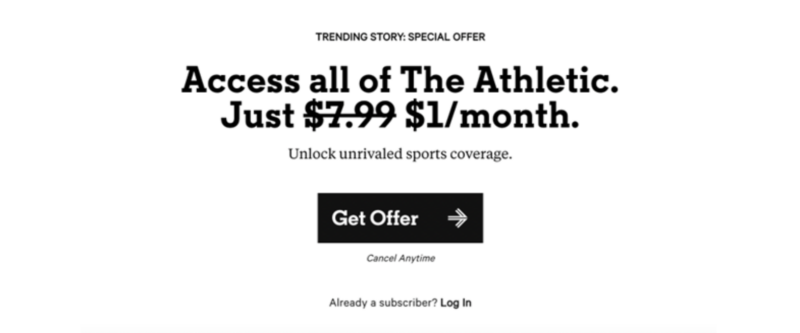5 reasons why your paywalls aren’t working
Last updated: May 13, 2024

For media companies, paywalls are one of the most effective ways to generate revenue for media companies. But paid content is a hard sell for generation that grew up on free Internet. (Google “how to bypass a paywall” and you’ll get enough tips to make an audience manager cry.)
The success of your paywall really comes to execution: Are you gating the right content? Can a non-subscriber get a good enough idea of your topical coverage and content quality before they’re asked to pay? Are your paywall messages themselves strong enough to push potential subscribers toward a purchase?
Learn how to create paywalls that provide revenue and value with these best practices:
Master subscription models: 9 Proven tactics to skyrocket retention & revenue:
You’re putting too much content (or not enough) content behind a paywall
If people can’t get a sneak peek of your content before asked to buy, many of them just won’t bother. So how much of your content should you put behind a paywall? How much should be left to the masses?
According to research from The Audiencers, the optimal premium content visibility is between 10-40% (that is, expose 10-40% of your website visitors to gated content). Any more and you risk losing readers before they check you out, any less and you risk missing revenue opportunities.
You’re not adding enough value to your subscription
Unless you’re in legacy news or a hyper-specific niche, your target audience will probably be able to find similar content elsewhere for free. That doesn’t mean you should give up charging for a subscription. Instead, increase the value of your offer by adding exclusive features to your package.
Stuck for ideas? You could make interviews with thought leaders or access to events exclusive to subscribers, offer subscribers-only how-to guides and networking opportunities, or create a Slack or online community for them.
For example, Taunton Press, one of our clients, includes digital plans and how-to videos in its subscription package for Fine Woodworking, one of its titles. This way, subscribers can read about woodworking, then learn how to put their advice to use for their own projects.

Whatever you choose, think of ways to turn your publication into a community of people interested in the same topic. This approach doesn’t just attract more subscribers, it attracts better-fit subscribers that’ll stick around long term.
Make this messaging clear on your meter and paywall messages to encourage more conversions and subscriptions.
You’re not paying attention to how people interact with your website
For best results, you need a clear understanding of how your audience is responding to your website. What pages are most and least popular? What messages are most and least effective? Go through your website analytics to shed light on your audience’s preferences and adjust your meters accordingly.
If you’re an Omeda customer, you can use our CDP to see which parts of your website yield the most clicks, views and time on site. You can see which of your articles and landing pages generate the most evergreen traffic and focus your paywalls on those pages.
And if you use Omeda’s meters, you also get dedicated performance reports for each of your meters, including what message was shown and which people clicked each link in the meter. With this information, you can quickly spot your most effective meters and implement them across your site.
Your paywall message isn’t convincing enough
So far, we’ve discussed the strategy behind premium content. But the message on the paywall itself can often make the difference between converting a subscriber and losing them for good.
If your paywall just tells people they can’t read anymore unless they pay you, it’s unlikely to work. Instead, use your paywall as an opportunity to reiterate your publication’s value.
But you’ve only got so much real estate on your paywall, so what exactly do you say?
Your paywall message should outline the value, content and everything users get in exchange for their payment. Use simple, action-oriented verbs to create a sense of urgency.
The Athletic’s paywall does this well: The headline — “Access all of the The Athletic” tells you what you “need” to do, then the discounted pricing implies a sense of urgency – sign up now before the price reverts to $8/month.

Another point to consider: Your paywall message shouldn’t just answer the question “What do you have?”. You’re competing with an infinite number of digital content providers, so you also need to answer, “Why should I choose to subscribe to you over similar publications?”
We also see this in The Athletic’s example, with “Unlock unrivaled sports coverage” re-emphasizing the quality of its sports journalism coverage.
Don’t be afraid to drive home the value of your subscription — now’s the time to brag.
Your payment process is confusing
Most consumers are naturally resistant to recurring financial commitments (who hasn’t gotten locked into an extra month of their gym membership because they cancelled two days after the deadline?). To increase paid subscriptions, you need to proactively address and combat that fear.
Smooth the path from paywall to purchase with these steps:
- Lead customers to a preference page, where they can opt in and out of specific publications and communications from you.
- If you’re offering a first-time or promo price, transparently communicate the “usual” annual price, as well as the date the higher price takes effect.
- Make clear that it’s easy to unsubscribe (while this is counter-intuitive, this reassurance alone can convince people who are on the fence to take the leap).
- Send customers a confirmation email upon purchase, including sign-on information and other relevant customer support information (like a contact email or phone number).
Interested in how Omeda can help you drive more subscribers? Request a demo and see it firsthand.
Subscribe to our newsletter
Sign up to get our latest articles sent directly to your inbox.
What you should do now
- Schedule a Demo to see how Omeda can help your team.
- Read more Marketing Technology articles in our blog.
- If you know someone who’d enjoy this article, share it with them via Facebook, Twitter, LinkedIn, or email.